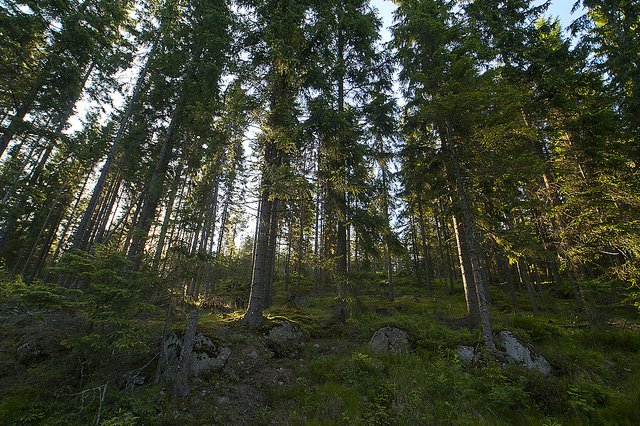
If there’s one thing that comes to mind when you think of Sweden besides Ikea and meatballs, it’s probably forests. They cover nearly 70 percent of the country. As a result, Swedes have a very close relationship with their forests, though the nature of it has changed in the last few decades.
Swedish forests have traditionally been accessible to all, regardless of ownership. People could walk into any old forest to gather firewood or pick berries. Berries in particular hold a special place in Swedish hearts. People still take weekend walks to pick lingonberries and blueberries. In fact, the Swedes love their berries so much that one paper from 1980 asked the question if picking, in conjunction with timber harvesting, was endangering berry supplies for future generations! But berries aren’t their only passion—hunting, fishing, and hiking are also high on the list.
Since transitioning from an rural society to an urbanized one between 1930 and 1970, Sweden’s forests have also undergone significant changes. As people no longer required a woodlot for self-sufficiency, industrial logging intensified. Timber companies reduced time between cutting from hundreds of years to 60 or 80. They also favored fast growing pines and spruces at the expense of old growth and deciduous species. After large clearcutting operations, companies replaced mixed age, mixed species stands with monocultures. With rising environmental awareness, practices changed in the 1990s, and clearcut sizes decreased while deciduous tree populations grew.
The Swedes’ deep devotion to the forest is hard to shake, and despite moving to the city, Swedes remain attached to their time outdoors. Still, the way they used the forest changed. Two surveys, one in 1977 and the other in 1997, illustrate this nicely. By 1997, more people frequently visited—more than three times a week, perhaps to retain some connection to nature. Yet at the same time, berry picking wasn’t very popular, except for people in the older age groups. That’s not to say the Swedes lost their taste for berries—the average respondent picked 4.5 liters in 1997. But it’s apparent that berry picking is a pastime that’s slowly being lost in the bustle of city living.
The authors suspect the shift is because older generations still retain personal bonds to the countryside. While older Swedes may not have lived in the country themselves, perhaps they had relatives who did. Younger people were born in the city, and do not share the same attachment to specific locales. For them, any forest will suffice.
Indeed, the study also found evidence of this, albeit in a roundabout way through the distances people had to travel to get to a forest, which both rose and fell. The proportion of very short visits and very long visits dropped, while medium length visits (3-4 km) rose. The authors postulate a few reasons for this dichotomous change. Most people currently live further from the forest than their predecessors, reducing the number of very short distance trips. At the same time, these people may not have an affinity for one particular forest over another, and so do not travel as far to undwind. The rise in medium length visits merges these effects—increased physical and emotional distance from the forest.
As an American, I’m struck by two things: The level of access Swedes have to their forests, and their commitment to them. Both are captured by a simple fact. Just a few miles from central Stockholm, a city of 850,000, large forests remain.
Sources:
Axelsson, A. (2001). Retrospective gap analysis in a Swedish boreal forest landscape using historical data Forest Ecology and Management, 147 (2-3), 109-122 DOI: 10.1016/S0378-1127(00)00470-9
Convention on Biodiversity. 2011. Country Profile – Sweden.
Linder, P., & Östlund, L. (1998). Structural changes in three mid-boreal Swedish forest landscapes, 1885–1996 Biological Conservation, 85 (1-2), 9-19 DOI: 10.1016/S0006-3207(97)00168-7
Lindhagen, A. (2000). Forest recreation in 1977 and 1997 in Sweden: changes in public preferences and behaviour Forestry, 73 (2), 143-153 DOI: 10.1093/forestry/73.2.143
Kardell, Lars (1980). Forest mushrooms and berries—an endangered resource? Ambio, 9 (5), 241-247
Photo by Kjell Eson.
Related posts: